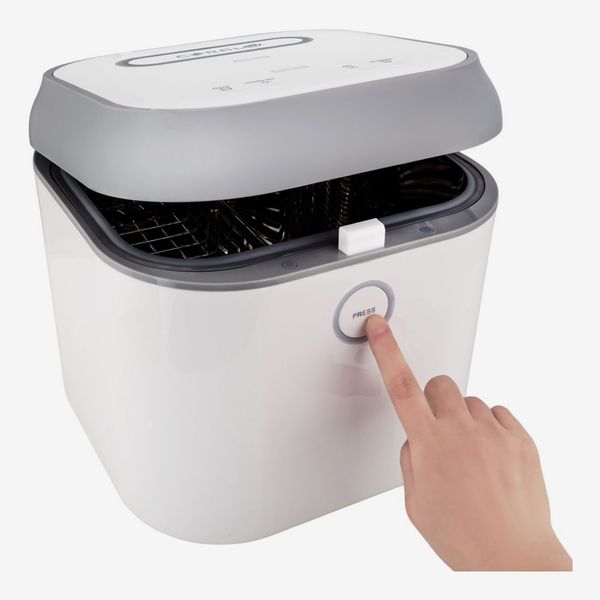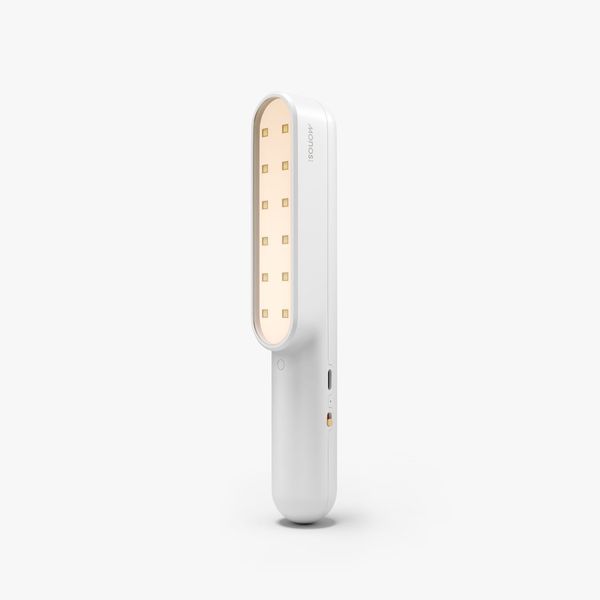
We first heard about the disinfecting powers of UV-C light (ultraviolet light with a wavelength between 200 and 280 nanometers — and the same light that causes sunburn and skin-cell mutation in humans) while talking to certified sex coach Gigi Engle about the best rabbit and bullet vibrators you can buy online. She uses a UV-light sterilization pouch to clean her sex toys of bacteria that could lead to yeast infections or bacterial vaginosis. According to her, UV light is much more convenient than soap and water. “You just need to wipe off your toys and pop them in the pouch and you’re done,” she says.
That made us wonder: If UV light is better than soap at cleaning sex toys, what else might it be useful for cleaning? To find out, we talked to five medical professionals (and one Strategist staffer who swears by her UV-light-blasting water bottle). Eric Lee, a St. Louis–based physician, says that “UV light, the type used in most common devices on the market to clean household objects, has been shown to be effective in laboratory studies at killing bacteria on computer screens, toothbrushes, and other objects. It has also been shown to affect viruses in similar ways that it affects bacteria.” According to Alex Berezow, a microbiologist and senior editor at Big Think who has written on the topic, “UV light is lethal to bacteria and viruses because of its high frequency that scrambles and damages their nuclear material. When it damages the DNA (or RNA) code of these pathogens, it also triggers lethal mutations that prevent them from reproducing properly.” (As we all protect ourselves from unnecessary coronavirus exposure, we also asked if the existing technology was effective against it. According to Dr. Aaron Glatt, the chair of medicine at Mount Sinai South Nassau and a spokesman for the Infectious Diseases Society of America, “there’s just not enough evidence to say whether [UV light devices] are an effective tool against COVID-19 or not.” Berezow, however, says, considering that “UV light kills everything — bacteria, fungi, viruses — it should kill coronavirus.” What we do know for sure is that it is effective against other viruses like the flu.)
With their advice in mind, we found a number of devices that use UV light to kill a range of dangerous bacteria and viruses from MRSA to E. coli. One of them is a UV-light-emitting robot that quite literally zaps operating rooms clean of all pathogens. Another is a giant UV light wand designed by Boeing to disinfect the insides of airplanes.
Outside of those industrial uses, there are a bunch of portable UV sanitizing boxes, wands, and water bottles that claim to kill 99.9 percent of bacteria and viruses on phones, toothbrushes, pacifiers, and a number of other surfaces. We’ve found the best available online and included them below. Note that, while none have been proven to kill the coronavirus, a number of them have been put through rigorous third-party lab testing to support their claims. And just in case we need to say it, UV light should never be used on the skin or any other part of the body. Also, you should be careful not to look at it when using a UV-light device to clean objects or surfaces.
[Editors’ note: No matter how effective these devices are at killing germs, none of them can replace frequent hand-washing, social distancing, and wearing face masks.]
Linda Lee, environmental health expert and chief medical affairs and science officer at UV Angel, says UV light and chemicals like bleach or ethanol are equally effective methods for sanitizing surfaces. She suggests using whatever cleansing method is available to you, but points out that, in some situations, UV treatment can be superior. “For instance, chemical treatment might be difficult for a baby’s pacifier, because the way chemicals work, there’s a residual left behind that continues to treat the surface,” she says. So maybe don’t scrub your baby’s pacifier with a Clorox wipe and then hand it right back to them. Another benefit of UV light over wipes or paper towels is that you create less waste. Although Linda Lee has not tested this product, Munchkin claims that it has been put through rigorous testing by an independent lab.
This sanitizer, also made by Munchkin and 59S, is designed to sanitize larger things like kids’ toys, baby bottles, cell phones, or other household items. It takes just five minutes to kill 99.9 percent of bacteria and viruses. Plus, it’s lightweight and folds down for easy carrying.
Here’s a similar sanitizer from Coral UV that fits up to four bottles with caps and nipples. And its effectiveness has been tested by an independent laboratory.
The skin in and around your private parts is extra sensitive. So whatever you use to clean your vibrators, butt plugs, and menstrual cups should be gentle and shouldn’t leave a chemical residue. Cleaning sex toys is especially important if they are used by more than one person, says Eric Lee, an ER physician, medical director of several nursing homes, and medical expert for Invigor Medical. “It is completely appropriate to want to disinfect it thoroughly between uses. A single exposure to certain pathogens during sex can lead to lifelong illness,” he says. Engle uses bVibe’s pouch sterilizer because it’s way less bulky than the bigger boxes like the Uvee Home Play and easier to travel with. “That’s a big plus because I’m international,” she says.
Berezow, Eric Lee, and Linda Lee all agree that UV light is most effective when used to disinfect something that is likely to come into contact with germs from multiple people. So under normal circumstances, or if you’re staying mostly home due to social distancing and not touching anything from outside your personal bubble because of coronavirus, “the germs on your phone are most likely the same germs that are normally found on your hands,” says Berezow. Since most people touch their phones thousands of times a day, killing those germs is rendered pointless once you pick it up and start swiping again. That said, if you leave the house to go grocery shopping, you should be cleaning your phone when you return — preferably before cleaning your hands. You can do that with an alcohol or Clorox wipe, or you can drop your phone in a box like this (though, again, UV light has not yet been proven to kill the coronavirus). And in general, if your baby drops their pacifier on the grocery-store floor or shares a toy with every kid on the playground, disinfecting it with UV light could reduce the spread of germs. This UV sanitizer from 59S can be used to disinfect phones and keys as well as small objects like pacifiers, toys, or even teething rings.
This UV-light sanitizing box fits a phone, keys, or other small objects. Plus it doubles as a wireless charger.
“I think these devices would make more sense in public places,” says Berezow, who strongly believes that industrial UV-light devices could reduce the transmission of diseases on a large scale if used in airplanes, restaurants, and other places where people congregate. “Unfortunately it’s an inconvenience and expensive,” he says. For now, and as an alternative to chemical cleaners, many UV sanitizing wands have been shown to work about as well as a Clorox wipe at killing bacteria and viruses on smooth nonporous surfaces like airplane tray tables or cell phones. After looking into the research around UV wands for the Strategist, Berezow says, “I would say that UV-light wands may be useful as an alternative to chemical cleaners on tabletops or other ‘plain’ surfaces.” But he couldn’t find any information regarding rough services like fabric or hotel bed sheets. Purvi Parikh, an immunologist and allergist with Allergy & Asthma Network, says that portable devices such as this “are helpful on surfaces and objects such as your phone but should not be used on your skin.” 59s recently came out with this folding UV-light wand that shuts off automatically to protect your eyes when it is turned upside down. According to the manufacturer, its lights have a life span of 10,000 hours, and it can kill up to 99.9 percent of germs on keyboards, desks, sofas, and bathtubs in just three minutes.
During the pandemic Canadian luggage company Monos pivoted from making hard-shell suitcases to this sleek UV-light sterilization wand. Monos is donating a portion of the proceeds from sales to the United Way India COVID-19 National Response Fund.
Like the options above, this portable UV-light wand is designed to kill 99.9 percent of surface bacteria as well as most viruses and mold spores. For best results, the brand recommends holding it two to three inches away from the object you want to sterilize, for at least ten to 20 seconds. It’s also important to note that this wand will not shut off when turned upside down. So you should use caution to not look directly at the light when using it.
There are also several water bottles and bottle caps that harness UV light to kill germs in your water, reducing bad odors and in some cases making the water safer to drink. Strategist associate director of audience development, Stephanie Downes, who is immunodeficient and extra sensitive to bacteria due to her Crohn’s disease, got a Larq water bottle as a gift from her sister after several water bottles with built-in filters didn’t work for her. She says “because of my Crohn’s I can’t drink water from the tap. At home, I have a Berkey filter, but it’s nice to have this with me when I am out of the house so I can pour tap water in, press a button, and make it drinkable.” For a slightly less expensive way to sanitize your water, you can purchase this UV bottle cap that fits most S’well-shaped water bottles.
The rechargeable Katadyn SteriPEN water purifier uses UV-C light to kill 99.9 percent of protozoa (including diarrhea-causing Giardia and Cryptosporidia), bacteria and even viruses. It was designed for backpackers and travelers as a waste-reducing alternative to buying bottled water. The company claims it can sterilize 16 fluid ounces of hot or cold water in less than a minute and 32 ounces in 90 seconds.
The Strategist is designed to surface the most useful, expert recommendations for things to buy across the vast e-commerce landscape. Some of our latest conquests include the best acne treatments, rolling luggage, pillows for side sleepers, natural anxiety remedies, and bath towels. We update links when possible, but note that deals can expire and all prices are subject to change.


















